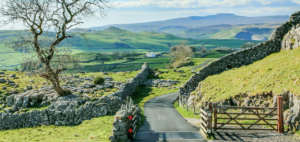Living Root Bridges: Exploring the Symbiosis of Indian Heritage and Ecosystems

Updated On: April 01, 2024 by Panseih Gharib
In the dense, rain-soaked forests of northeastern India, an extraordinary marriage of nature and human ingenuity unfolds. The living root bridges of Meghalaya, an embodiment of the symbiotic relationship between the indigenous communities and their environment, have stood the test of time. Ingeniously crafted by the Khasi and Jaintia peoples, these structures are not built but grown from the aerial roots of the Rubber Fig trees, ingeniously guided across rivers and ravines to create a resilient and living means of passage.

These bridges are more than marvels of natural architecture; they represent a deep cultural significance and communal labour, often spanning generations to mature. As eco-friendly solutions with a low environmental impact, they serve as a testament to sustainable practices long before the concept became a global imperative. The commitment of the local communities to maintaining and nurturing these bridges not only emphasises the harmony with nature but also enhances their cultural heritage, creating not just a functional infrastructure but also a living legacy that merges the past with the present.
Key Takeaways
- Meghalaya’s living root bridges are a unique fusion of ecological ingenuity and cultural heritage.
- They exemplify sustainable practices and community commitment in infrastructure development.
- These structures serve as a functional legacy, growing stronger with time and use.
The Ancient Art of the Living Root Bridges
In the lush rainforests of Meghalaya, an incredible fusion of culture and nature endures through the ancient art of the Living Root Bridges. These bridges showcase a harmonious relationship between the Khasi tribe and their environment, a testament to their ingenious craftsmanship.
Historical Significance
These Living Root Bridges, known locally as Jingkieng Jri, represent a time-honoured tradition dating back centuries. They are more than mere crossings; they symbolise the adaptability and resilience of the Khasi people. By guiding the aerial roots of rubber fig trees across rivers and streams, the Khasi created a sustainable solution to navigate the rugged topography of their homeland.
The Khasi Tribe’s Ingenious Craft
The Khasi tribe’s intuitive connection with nature is evident in their creation of the Living Root Bridges. These organic structures are nurtured over decades, carefully handwoven, and strengthened to bear the weight of those who walk across them. This craft is not only practical but also an embodiment of their culture and heritage—a craft that we witness today as a marriage of nature’s patience and human ingenuity.
Remarkable Ecosystems of Meghalaya
In Meghalaya’s lush realm, we find a synergy between the natural world and human ingenuity, a testament to the biodiverse ecosystems that thrive here. The iconic Ficus elastica tree is not only a vital component of these ecosystems but also a foundation for cultural expression.
Flora and Fauna Diversity
The state of Meghalaya is a treasure trove of biodiversity, hosting numerous species that enrich its ecosystems. These forests are bustling with life—from orchids that drape the treetops in a panoply of colours to the elusive clouded leopard stalking silently through the underbrush. A quick glance reveals layers of interaction among flora and fauna, evidence of a complex web that supports life here in profusion.
Importance of Ficus Elastica
The Ficus elastica, or Indian rubber tree, assumes a central role in these ecosystems as an ecological engineer. With its strong, resilient roots, it forms the backbone of the Living Root Bridges, blending natural growth with human need. Notably in the East Khasi Hills, these structures showcase a harmonious balance man has struck with nature, enriching both cultural identity and the biological fabric of the state.
Mechanisms of Root Bridge Formation

In the lush landscapes of India, living root bridges stand as a testament to the symbiotic relationship between nature’s ingenuity and human resourcefulness. We explore the intricacies of their development, where the congruence of biology and traditional techniques culminate in architectural marvels.
The Interplay of Roots and Environment
The formation of these bridges begins with the guidance of the Ficus elastica‘s robust aerial roots across rivers. Over time, these roots grow and intertwine with the surrounding environment. In the stewardship of the Khasi and Jaintia peoples, the roots are meticulously directed using hollowed-out areca nut tree trunks or bamboo frameworks, which serve as temporary supports for the root bridges to span gaps and waterways. As the roots fortify and become self-supporting, these living structures can sustain the weight of approximately 50 people at once.
Aerial Roots and Architecture
The architecture of these bridges takes advantage of the aerial roots’ natural tendency to merge and solidify. This process, called anastomosis, allows the strands to fuse and create a durable, self-renewing bridge that can last for centuries if cared for properly. The longevity of a root bridge hinges upon its continuous growth and reinforcement, showcasing a remarkable application of an organic material—roots—and sustainable architecture. For example, bamboo is often employed as a support structure for the roots to weave through, contributing to the bridge’s strength and durability. These living bridges utilise the aerial roots of the Ficus elastica, invoking both the tree’s natural capacities and the local community’s dedication to fostering connections within their environment.
Cultural Significance and Community Practices

In this section, we explore the profound connections that the Khasi tribal communities of Meghalaya have with their Living Root Bridges. These bridges are not just marvels of eco-friendly architecture but are deeply intertwined with the cultural identity and practices of the people.
The Khasi Way of Life
The Khasi tribal communities pride themselves on their unique relationship with nature, which is most vividly represented in their Living Root Bridges. These bridges, known as Jingkieng Jri, are not merely structures but a testament to the Khasi’s intimate bond with their environment. Created from the roots of the Ficus elastica tree, they are cultivated over generations and form essential paths that link individuals, symbolising not only physical but also social connectivity. Heritage and tradition are carried forward by each generation as they maintain and nurture these living connections.
Nature-Culture Intertwining
Our understanding of Culture-Nature reciprocity is exemplified by the Living Root Bridges. These structures are a cultural hallmark; they encapsulate a system where Khasi practices have evolved in harmony with their forested surroundings. The bridges reflect an indigenous knowledge system that underlines not just survival but a sustainable and respectful co-existence with the ecosystem. As living organisms, the bridges grow stronger with time, embodying a legacy of ecological wisdom that has been passed down through the ages. This cultural phenomenon shows us how communities can thrive sustainably by adapting their ways of life to the natural world around them.
Sustainability and Ecological Impact
In this section, we’ll explore the innate sustainability of Living Root Bridges and their role in ecological conservation, particularly concerning environmental stability and climate change.
Living Bridges and Environmental Stability
Living Root Bridges, a remarkable example of bio-engineering, embody sustainability in their very essence. These bridges are formed from the aerial roots of rubber fig trees, which, over time, are guided and woven by local communities into sturdy, living structures capable of enduring for centuries. Through their intertwining with the surrounding ecology, they enhance the stability of riverbanks, prevent soil erosion, and contribute to the ecological health of the forested areas in which they are found, such as in the wettest place on Earth, Meghalaya.
Combating Climate Change
The cultivation and maintenance of Living Root Bridges present a unique interplay between cultural tradition and nature conservation, which holds significant potential in the fight against climate change. These living structures actively sequester carbon throughout their growth, helping to mitigate greenhouse gas concentrations. Furthermore, as a sustainable alternative to conventional construction, they require no manufactured materials, thereby reducing environmental footprints. Their enduring presence is a testament to the foresight of indigenous communities in the realm of ecological preservation.
Socio-Economic Aspects and Tourism

In the serene landscapes of Meghalaya, India, the Living Root Bridges stand as a testament to the harmonious relationship between nature and culture. These organic structures not only serve as vital connections for local communities but also foster socio-economic development through tourism, creating a symbiotic relationship between villagers and visitors.
Boosting Local Economy
The creation and maintenance of Living Root Bridges contribute significantly to the local economy. Villagers have an opportunity to participate in a burgeoning tourism sector, which has been bolstered by the global appeal of these unique architectural wonders. The economic growth fostered by Living Root Bridges is palpable, as the influx of tourists translates into increased demand for local goods and services. This demand can lead to entrepreneurial opportunities, such as lodging, guided tours, and cultural experiences, ultimately leading to overall economic prosperity for the local community.
Tourist Spending:
- Lodging
- Guided Tours
- Local Crafts
Employment Generation:
- Tourism Services
- Bridge Maintenance
- Culture & Heritage Preservation
Responsible Tourism
We acknowledge the importance of responsible tourism in the context of Living Root Bridges, which aligns with our dedication to sustainable travel. When tourists visit these bridges, it’s vital that they do so with a sense of responsibility, ensuring that their presence doesn’t negatively affect the environment or the local villages. By prioritising activities that respect the natural habitat and the community’s way of life, tourists can enjoy a rich, authentic experience while contributing to conservation efforts and cultural preservation. This approach helps maintain the integrity of the Living Root Bridges and their surroundings, ensuring that they remain a source of inspiration and fascination for future generations.
Cultural Sensitivity:
- Engaging with Villagers
- Learning Local Traditions
Environmental Protection:
- Following Designated Paths
- Supporting Conservation Initiatives
Through responsible tourism, we aim to establish an equilibrium, sustaining the magnificence of the Living Root Bridges while invigorating the economy and enhancing connectivity between the villagers and tourists.
The Art of Maintenance and Restoration
The living root bridges of India are not only a testament to the ingenuity of traditional practices but also require ongoing maintenance and restoration to preserve their structural integrity and cultural significance.
Traditional Techniques
Maintenance: Our traditional methods of caring for the living bridges involve regular inspections to assess their health and stability. The local communities continue to utilise the knowledge passed down through generations to mend and strengthen these structures. The roots are carefully guided over and around steel and bamboo frameworks to extend or repair the bridges as needed.
- Restoration involves replacing decaying elements of the foundation and any supporting structures. This ensures that the bridges can withstand the monsoon seasons and the weight of those who cross them.
Modern Conservation Efforts
Conservation: In recent years, we’ve seen a surge in efforts to conserve these architectural phenomena through collaboration with ecologists and conservationists. They work alongside local artisans to integrate modern understanding with time-honoured techniques.
- Living Bridge Foundation: Foundations and organisations contribute to the conservation of root bridges by providing funds and resources needed for their upkeep. These collective efforts help in the documentation of these bridges and in sharing the traditional knowledge associated with their creation and care.
Maintenance and restoration of the living root bridges are fundamental not only for the safety of the communities that rely on them but also in preserving a living piece of cultural heritage that we remain proud of.
Aspiring for UNESCO World Heritage Status
We recognise the profound interconnection between culture and nature embodied in the Living Root Bridges of India, as they embark on a journey toward gaining UNESCO World Heritage Site status. This recognition would not only honour the indigenous knowledge of the Khasi tribe but also elevate the bridges as a testament to sustainable heritage.
Global Recognition of Indigenous Practices
It is their ingenious natural design and cultural significance that have led the Living Root Bridges to be included on UNESCO’s tentative list for World Heritage status. These bridges, handmade from the aerial roots of the rubber fig tree by the locals, showcase how human creativity can harmoniously coexist with the environment. By recognising these structures, UNESCO is acknowledging the efforts of the Khasi tribe who have long been the custodians and artisans of this living tradition.
Challenges and Prospects
In aspiring for World Heritage designation, the challenges are as significant as the prospects. Preserving the bridges while encouraging sustainable tourism becomes a dual challenge that requires meticulous planning. The prospects, however, are uplifting, as global recognition could bolster conservation efforts and provide economic benefits through responsible tourism. If endorsed as a World Heritage Site, the Living Root Bridges would not only gain the protection they deserve but also bring focus to the rich heritage and ecological acumen of the local communities involved.
Educational Role and Knowledge Transfer
Our exploration of the Living Root Bridges in India reveals not just an architectural marvel, but also a rich source of knowledge and learning that underscores the importance of preserving indigenous practices.
Learning from Ancient Wisdom
The art of creating Living Root Bridges, locally known as jingkieng jri, represents a vital component of indigenous knowledge passed down through generations. These bridges, stemming from the ingenious use of the Indian rubber fig tree (Ficus elastica), embody ancient wisdom of the Khasi and Jaintia peoples in Meghalaya. Schools in the region can draw upon such traditional techniques, incorporating them into the curriculum to teach students about sustainable living and environmental conservation.
Intergenerational Teaching
The tradition of crafting Living Root Bridges is a quintessential example of an intergenerational growth process. It involves skilled elders, such as the venerable Hally War of Siej village, teaching younger members of the community the meticulous process, which ensures the continuity of this age-old practice. This teaching extends beyond the mere construction of bridges, focusing also on the long-term care and strengthening of these living structures. In absence of a formal written script documenting the technique, this oral and hands-on method of education is crucial for the survival of the practice, imbuing it with personal narratives and cultural significance.
Living Bridges in Literature and Media
The enduring allure of India’s living root bridges has captivated storytellers and filmmakers alike, weaving their unique presence into the fabric of our cultural expression.
Documenting the Marvel
We have seen a surge in interest towards these botanical architectures, as journalists and researchers aim to capture their intricacies. An exceptional account of the living bridges can be found in works such as “The Artisans Behind India’s Living Root Bridges” by Atlas Obscura, detailing the cultural and practical aspects of these natural wonders through the eyes of the locals who maintain them. Similarly, the BBC has also featured the living root bridges, shedding light on their potential to inspire sustainable architectural practices.
Living Bridges as a Muse
These bridges have not only been a subject for non-fiction but also for artistic inspiration. Their blend of nature and utility resonates with our innate appreciation for harmony, which is often reflected in literature and visual media. The identity and culture linked with the living root bridges are interwoven into storytelling, finding their way into novels, poetry, and films—capturing the imagination of audiences across the globe. This muse-like quality underscores their significance beyond mere physical structures, embellishing the cultural tapestry with their organic tales.
Frequently Asked Questions
As custodians of knowledge, we share insights into the living root bridges of India, structures that are not only architectural marvels but also a testament to the profound relationship between nature and culture.
How are living root bridges constructed?
The living root bridges are created by guiding the aerial roots of the rubber fig tree across rivers and streams, a process that can take 10-15 years to complete. This intricate art is practised by the indigenous Khasi and Jaintia people of Meghalaya.
What is the historical significance of living root bridges in Meghalaya?
These bridges have been used for centuries to connect remote villages across rushing rivers. Root bridges are deeply interwoven with the history and daily lives of the local communities, reflecting their intimate understanding of the land.
Which indigenous communities are known for creating these structures?
The Khasi and Jaintia tribes of Meghalaya are known for their skill in creating living root bridges. This traditional knowledge has been passed down through generations.
In what way do living root bridges symbolise the harmony between nature and local culture?
Living root bridges represent a harmonious balance, with the community nurturing the growth of the bridges and in return, the bridges providing vital connectivity and support to the people’s way of life.
What environmental conditions are required for the growth of living root bridges?
High humidity, consistent rainfall, and the robust growth of the Ficus elastica tree are essential for the successful cultivation of living root bridges. Meghalaya’s unique climate provides the perfect conditions for these natural structures.
How do living root bridges contribute to sustainable tourism in India?
Tourism centred around living root bridges promotes local economies while spotlighting sustainable practices. Visitors are offered a unique, eco-friendly experience that highlights the ingenuity of local communities and their ability to live in harmony with their environment.






